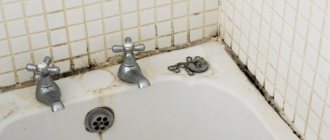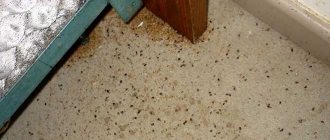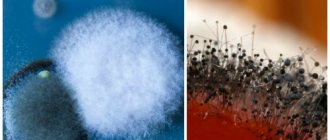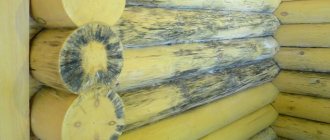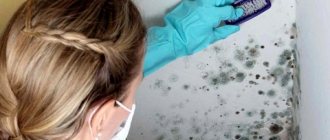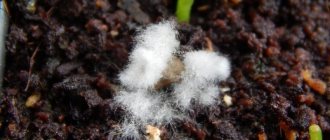The appearance of mold in the house may indicate possible problems with air ventilation and dampness in the room. It usually appears in the bathroom, kitchen, ceiling, walls. When favorable conditions arise for it, it appears on the walls of the wardrobe and storage shelves. How to get rid of mold in your clothes closet, as well as how to avoid the spread of infection, these questions take many by surprise. If a fungal infection (mold) is detected, it is necessary to urgently take action to eliminate it, since, in addition to damaging things, it causes serious respiratory diseases. What is the impetus for the development of fungal plaque? I recommend reading “Mold Allergy.”
The smell of new furniture
New cabinets almost always smell like varnish.
The evaporation of formaldehyde that is part of the chipboard can also add its own note to this sharp bouquet. If the furniture is of high quality, the smell will disappear within 2–3 weeks. If this does not happen, the owners will have to either return the purchase to the store, or constantly use odor absorbers. The new cabinet is installed in a well-ventilated area, the doors are left open. Weathering will speed up if you place cups of soda in the corners of the cabinet and tea bags (new or carefully dried used ones) on the shelves. If the smell does not completely disappear, you will need to keep the soda and tea in the cupboard constantly, changing them every 3-4 weeks.
Carry out the treatment only after the closet is completely empty of clothes. Today, there are several simple methods that can at the same time kill harmful spores and save wood from further damage. Let’s look at the 2 most effective ones.
The most common method is to treat wood with soda solution. This method is suitable even for a cabinet with children's underwear, as it is safe. Dissolve 3 tbsp in a liter of water. l. soda, then wash the inside of the cabinet with the resulting solution, including all sides, shelves, walls and doors. Leave the cabinet open for 4 days. You can also use hydrogen peroxide. Treating children's cabinets with peroxide is as safe as using soda.
Another effective method is chlorine bleach. But keep in mind that this method of dealing with the problem is not suitable for everyone, since chlorine causes an allergic reaction in many people. The method is suitable for processing a closet where the clothes of adult family members are stored. Carrying out such treatment is unacceptable for disinfecting children's furniture.
First, you should remove all clothes from the closet and dry the inner surface using a special dryer or fan, and only then proceed directly to disinfection. It is better to take the wardrobe out of the room into the open air so as not to breathe in harmful fumes.
Mix equal parts water and chlorine bleach, put on gloves and use the resulting solution to wipe all the walls and shelves of the cabinet, inside and out. When done, wash the cabinet with clean water. It is advisable for the wardrobe to stand for about 3 days in the fresh air, which will help eliminate the unpleasant smell of chlorine.
When processing wardrobes using this method, you do not need to add additional detergents to the water so as not to harm your health. Using bleach allows you to completely clean the surface, which ordinary soda, which is best used at the initial stage of infection, cannot cope with.
Causes of fungus and unpleasant odor
You will forget about the bad-smelling clothes and bedding stored in the closet only after the mold is completely eliminated. Unfortunately, there are many factors that can contribute to poor air quality in your home. Let's take as an example those that can be really dangerous:
- High air humidity in the room, respectively - in the closet,
- Storing wet clothes and bad-smelling items on shelves
- Storing clothes that have been poorly washed from perfumes and antiperspirants,
- The special chemical composition of things,
- The cabinet is made of non-standard elements.
It is also worth noting that the correct location of the cabinet is of great importance:
- It is better if it is located far from the bathroom and kitchen,
- It is not recommended to install it in a corner; it is preferable to choose a more ventilated place.
Important!
Place only fresh and completely dry clothes in the closet. Even freshly ironed, clean clothes need to dry a little before you hang them in your closet.
Where to look for the source of mold?
Even if you smell mold in your closet, it doesn't mean it has spread there. The fungus lives in warm and humid places, which means it can be behind a closet wall, in peeling wallpaper, or right in clothes if they are not dried well.
The characteristic colors of mold are gray, green, blue, black. If you find it, immediately take measures to remove it, because the fungus spreads very quickly, affecting any surfaces along the way.
At first you will smell it and only after a while you will see the mold.
How can you tell if it's really the smell of mold if you can't see it yet? Its stench is bitter and damp.
Mold moves into closets with clothes from the following media:
- air ducts;
- rotten walls;
- the back of the furniture;
- rarely used books;
- carpet;
- mattresses;
- ceiling tiles.
The most unexpected places for mold to form
The appearance of fungal plaque is always accompanied by such factors as an increase in humidity and dampness, which is absorbed by furniture, walls, and ceilings. Due to its structure, mold fungus has an unlimited ability to penetrate deep into walls and furniture. The possibility of reproduction in a damp and humid environment increases several times, which results in a lightning-fast increase in lesions. Over time, clothing becomes infected. Rot in a closet can cause enormous damage to furniture and belongings. It is possible to detect mold only by completely checking the contents of things, the back wall of the cabinet, storage shelves, and the corners of the walls. Only after determining the location of the source of infection can we begin to eliminate the problem that has arisen. I recommend reading the article “How to get rid of mold in an apartment?”
How to treat kitchen cabinets?
Kitchen furniture, including household appliances, are also susceptible to mold odors. The first thing you need to do is wash the surface using a solution of water and laundry soap or bleach. Treat the doors, shelves, and walls with the composition.
As an alternative, you can use a vinegar solution, which is prepared using slightly warm water with the addition of seven tablespoons of vinegar. Put on gloves, treat work surfaces with vinegar solution and open the window wide. It is better not to enter the kitchen for several hours, and then you need to wash the surfaces with clean water.
After such procedures, do one of the most attractive things for you:
- Place saucers with coffee beans on the shelves. You can also use ground, but it must be natural. Soluble “sand” will not capture odors as well.
- Place 5 slices of fresh lemon in saucers and place on each shelf. Use the skins and zest too. Lemon absorbs odors perfectly.
- A small bowl of baking soda will absorb unpleasant odors in 3 days. Place containers in the farthest corners.
Sometimes housewives use aromatic products, for example, essential oils, but in the kitchen you need to be careful with this and use it only for walls and floors. In the same place where the products will be placed, the option with essential oils is not suitable.
Fungus and dampness are usually associated with living in an old house, but this is a misconception. Mold in the linen closet most often appears due to insufficient air circulation in the room. This problem is especially common among residents of private houses, although recently apartment owners have also been attacked by mold.
- Increased level of humidity in the room.
- Insufficient sealing of furniture and walls, adhesion of the walls of the old cabinet to the external wall of the house.
- Storing poorly dried clothes on shelves.
- Features of the chemical composition of fabrics.
- Poor quality materials and cabinet fittings.
A musty smell in kitchen cabinets is a sign that moisture has gotten inside or food is spoiling. They need to be taken out, spoiled ones should be thrown away. To remove the smell from the closet, wipe the shelves, inner surfaces of the walls and doors with vinegar. If the smell still remains, repeat the procedure.
Baking soda and vinegar are the most affordable remedies against unpleasant odors.
If the stench is strong, the shelves are fumigated with burnt sugar or dried citrus peels:
- Place a sheet of paper on a metal scoop and add 2-3 teaspoons of sugar. The sheet needs to be crumpled and set on fire. The aroma of smoke will not be very pleasant, but it neutralizes mustiness and quickly dissipates;
- Place the dried peel of a tangerine, orange or grapefruit on a scoop and set it on fire.
To finally deal with mustiness, several rye crackers, dried lemon, tangerine or orange peels are laid out on the shelves. Soda absorbs odors well. A vase of coffee, cinnamon, bay leaf, cloves or ground ginger will create a cozy atmosphere.
A musty smell may be a result of fungus attacking the cabinet walls. Most often, mold appears in furniture located near external walls. If this is the cause of the fungal attack, you need to either rearrange the furniture or treat the wall with a fungicidal agent.
You cannot put anything in a closet where mold has appeared until the fungus is completely destroyed. The affected area is wiped several times with hydrogen peroxide or boric acid. If the fungus appears again, use bleach. Deeply ingrained mold stains are scraped off, and the worn area is covered with varnish.
The products taken out of the cupboard are sorted out, the grains are fried (10–15 minutes in a hot oven). Cereals and pasta that smell moldy are thrown away. All dishes are washed in hot water with baking soda. In an apartment with high humidity, place bowls of salt in kitchen cabinets: it absorbs excess moisture well.
We suggest you read: How to remove sticky stains from clothes
The contents of the linen closet must be clean and dry. The smell of mold in the closet, and then the mold itself, can appear due to the fact that under-dried laundry was placed inside. Dry laundry that has been lying on shelves for a long time also smells unpleasant.
Once every six months, the entire contents of the cabinet should be removed and ventilated on the balcony in hot weather. To get rid of odors, wipe the inside surfaces of the walls and shelves with vinegar. If a fungus appears, the affected areas are treated with hydrogen peroxide, or in difficult cases with bleach.
Silica gel is an excellent prevention of high humidity and mold in the closet
Linen should be sorted out; if it is moldy or simply smells unpleasant, it should be washed. To keep your closet smelling fresh, place the following in piles of laundry:
- sachets with aromatic plants (lavender, rose petals, lilac leaves, mint);
- scented toilet soap (previously wrapped in cloth);
- empty perfume bottles;
- sheets of paper with perfume or essential oils applied to them (after applying the oil or perfume, the paper must be thoroughly dried).
Often the cause of an unpleasant smell from the wardrobe is the habit of some people of keeping clean clothes and stale clothes together. The smells of sweat and deodorants permeate clean clothes. If a smoker has such a habit, the smell of tobacco from the closet is guaranteed.
A musty smell occurs when undried outerwear is hung in the closet. If the furniture is too close to the outer wall of the house, mold will appear inside the cabinet. They fight mustiness and fungus in the same way as in the previous case: treat the walls with vinegar, wipe the mold stain with hydrogen peroxide (it can discolor the veneer, so first you need to test it on an inconspicuous area).
If the smell of mothballs is firmly ingrained in the wood of old furniture, mustard powder will help. It is scattered along the bottom and hung in the corners in bags made of thin cotton fabric. The doors are closed, and after 3-4 days the mustard from the bottom can be swept away.
Place jars of soda in the corners of the closet: it absorbs odors well. To reduce humidity, place silica gel packets along the bottom and in shoe boxes and place a jar of salt. A proven remedy against tobacco aroma is lavender. Also, the smell of tobacco smoke is effectively absorbed by wet fabric. Just hang a damp towel on the bar and close the doors. After an hour, the towel is changed. The procedure is repeated 3-4 times.
To keep ventilated items fresh, sachets with fragrant herbs are placed between the hangers. There is another way: tea bags are sprinkled with perfume or essential oils, dried and hung on a bar.
Tea absorbs odor no worse than other sorbents
- do not store clean and worn items after washing or dry cleaning together;
- Hang outerwear in the closet completely dry. During the wearing season, it is better to keep it on an open hanger;
- dry-cleaned items should be aired on the balcony for 1–2 weeks before hanging them in the closet;
- for sports, work, hunting, fishing, and tourist clothing, allocate a separate closet;
- If possible, change the insoles of winter shoes every season. Stuff shoe socks with newsprint; to neutralize the smell of sweat, place sachets with lilac leaves in drawers;
- do not store umbrellas in the wardrobe;
- do not smoke in the room where the wardrobe is located;
- Do not allow pets into the closet.
If you follow these simple rules, things in your closets will always smell fresh. To combat persistent odors, it is recommended to use special preparations, for example, OdorGone. Such products work faster than traditional ones, but the latter are more environmentally friendly.
Mold loves to thrive in dark and damp places. The basement, the lower part of the walls, the bathroom, and the kitchen are often invaded by a malicious fungus that poisons the lives of the residents of the house. If there is mold in the house, it can be detected by an unpleasant specific odor, the formation of dark spots, and the appearance of a coating in the form of white wool.
Often mold appears in flower pots due to excess moisture. It is not uncommon for a fungus to settle in a wardrobe. The worst thing is when the annoying moldy smell eats into your things. In this state they become unusable. How to quickly get rid of mold in a closet will be our topic of conversation today.
When you open the cabinet, the musty smell knocks you off your feet. This does not mean that the fungus has settled inside. It can be on the back wall, when the source is mold on wallpaper that has come off the wall, or under the floor. But sometimes it settles inside. An unpleasant odor spreads over long distances.
In order to choose the right weapon against a malicious enemy, you need to determine the source.
There are many reasons why mold appears in furniture, let’s look at them:
- Poorly dried items after washing, bed linen, kitchen towels. Dampness remains in the folds of tightly folded items for a long time, which means mold will appear instantly.
- The cabinet walls are closed very tightly and for this reason natural air circulation is disrupted.
- If there are fungal spores in the house and they fly in the air, then it can settle in any place where there are favorable conditions for it: dampness and darkness.
- It is difficult to detect mold in bookcases; only after the appearance of specific stains (brown, green, gray, etc.) can one determine the problem, which is caused by high humidity in the air.
- The most common health hazards found in kitchen cabinets are excessive dampness, accumulation of various food odors, darkness and lack of air.
What to do if clothes and shoes smell damp
If mold gets on things, you need to act quickly. To begin with, clothes are hung out in the fresh air and sun. Can be left for 3 or more days. After drying, treatment with special products is recommended.
Light or white things
Can be treated with hydrogen peroxide or bleach. The substances will quickly remove the stench and return it to its previous appearance. Soak the product and leave it for several hours. Wash with regular powder and rinse with fabric softener. The procedure is aggressive! May damage delicate, delicate fabric.
Colored products
It is optimal to use ammonia. It is mixed halfway with ammonia, and the finished product is applied to the site of contamination. After treatment, wash in warm water using a stain remover or strong powder.
Bedding set and cotton
To restore freshness, a simple product is suitable - onions. Rub freshly squeezed juice onto moldy areas and wash in warm water. You can use curdled milk; the soaking period lasts up to 12 hours.
- How to clean mold on plastic windows and slopes
- In what cases can mold appear in an apartment?
- Fighting the smell of dampness in the apartment
Products made from natural fabrics
Vinegar and freshly squeezed lemon juice are used for cleansing. Combine in equal quantities, pour onto the stain, sprinkle with a small amount of salt on top. Allow the fabric to dry and wash.
Linen
Fungus on linen clothes is removed with a mixture of ammonia 20 g, water 1 liter, table salt 20 g. Mix, put the product to boil on the stove for half an hour. Soak the item for a couple of hours, wash it by hand or in a machine, and dry it.
Cabinet treatment to remove fungus
Initially, an unpleasant odor appears in the closet, but later the person notices fungus on the surface. It comes in grey, blue, green or black.
You can process furniture in one of the following ways:
- The cabinet is washed on both sides with a weak solution of acetic acid or peroxide. After treatment, wipe and dry open for several days.
- Pieces of gauze soaked in vinegar are left on the shelves of antiseptic-treated furniture. Every other day, the wardrobe is wiped with ammonia and sachets are hung.
- Washed furniture is treated with ultraviolet lamp rays: irradiation kills fungal spores.
- The treatment is carried out with hot steam, after which the moisture is allowed to dry thoroughly.
- The shelves and walls of the wardrobe are washed with a soda solution, rinsed with clean water, dried for several days and several pieces of paper or fabric soaked in essential oils are placed in it. Soda does not cause allergies, it can be used for children's wardrobes.
If possible, the treated cabinet should be taken outside and allowed to dry for 2-3 days in the fresh air or provide a draft in the room.
How to remove fish odor from hands, clothes and dishes: effective methods of elimination
- lack of access to fresh air;
- increased humidity;
- presence of stale, dirty clothes in the wardrobe;
- smell of tobacco smoke;
- storage of vintage clothing.
All of these factors become the main reasons for the appearance of fungal plaque, and also serve as hotbeds for mold.
Be sure to read:
Smell from the kitchen sink: how to eliminate it, causes, effective methods
While the items are drying and washing, sanitize the closet. Furniture is moved away from the walls and, if sources of infection are already visible, they are removed with home remedies - baking soda, vinegar, alcohol (ammonia), citric acid, bleach and chemicals.
As additional measures after treatment, an aromatic sachet is used, which is placed directly in the closet and between layers of clothing after treatment.
All products have their benefits, but the safest of them all is baking soda. It is even suitable for processing cabinets with children's linen:
- Dissolve soda in water. Use 3 tablespoons per liter of water.
- Dampen a sponge or rag in this solution.
- Wipe down the cabinet walls and shelves. Pay attention to the back wall of the cabinet.
- After treating with the solution, wash the cabinet with clean water.
- Keep the cabinet open for 4 days until it is completely dry.
We suggest you read How to clean an iron with citric acid
Bleach can also deal with odors and fungal growths. But here you need to act differently:
- After emptying the closet of clothes, open the doors and place the dehumidifier inside. If not available, use a fan. If possible, move the cabinet outside into the open air in clear weather.
- Mix equal parts bleach and water and dampen all surfaces of the cabinet. It is very important not to add additional detergents to the composition, this can cause an unpredictable reaction and harm your health.
- After treatment, the inner walls of the cabinet are washed with ordinary cold water.
- Keep the cabinet open for at least three days, further drying it with a fan or dehumidifier.
Make sure there is no trace of odors left in the closet. Each corner of the furniture should be dried and only after that put the clothes back.
The following tools will also be useful:
- Vinegar. To apply to surfaces, dilute equal parts of water and vinegar, wipe the surfaces and leave to dry. Hydrogen peroxide works on the same principle.
- Bleaching. A good product, but not suitable for everyone. Its use can result in white spots on the furniture, so if the cabinet is expensive, try baking soda and vinegar first, and in extreme cases, use bleach.
- Chemicals. Use last because they are not always safe for use in adults or children. If you use it, follow the instructions carefully.
Ways to solve the problem
How to get rid of mold in the closet and the appearance of an unpleasant odor will only help with the right approach to solving the problem. How to remove mold from a clothes closet? To do this, you will need to carry out the following activities:
- Cleaning. First you need to ventilate the dressing room. Then take out all the clothes and hang them outside to air. Particularly carefully, using a soda solution and a rag, carry out a wet treatment on the shelves and walls of the cabinet. Instead of soda, you can use a cleaning product. Dry the dressing room and repeat the procedure after 3-4 hours.
- The next step is to remove fungal plaque and its smell. To do this, you can use a vinegar solution (9%). Take vinegar, mix it with water (ratio 1:3), wipe the site of infection. Since vinegar has a specific smell, you can use hydrogen peroxide or boric acid instead.
- If mold reappears in your clothes closet, only a radical approach will help. Empty the wardrobe of clothes, and instead of vinegar and boric acid, use bleach based on chlorine in a ratio of 1:4 to water. Put on rubber gloves, moisten the cloth with the resulting solution and slowly treat the affected areas of the wardrobe. Dry, repeat the procedure after 2-3 days, the fungal coating will leave your chest of drawers for a long time.
The presence of smell and mold in the wardrobe and things is not the whole negative set of the problem that has arisen. After its appearance, the fungus infects clothing within a matter of hours. What to do if the mold that appears in the closet begins to actively reproduce on things?
Folk and store-bought fragrances for clothes closets
If the fungus has spread to the walls of the closet, then it is probably already in things. Clothes are taken out to the balcony or outside in the sun on a clear day and aired, first turning them inside out - especially capricious items, so that the fabric does not fade in direct rays.
Simple airing will get rid of the smell and the fungus itself, so after drying, all clothes need to be washed. You don’t need to invent anything - just regular washing with powder. The use of additional odor removal products is encouraged. Linen is dried and always ironed.
But what should you do if, in addition to the smell, stains have formed on your clothes? Throw out old things and try to save new ones, but only if the infection is partial. They work with each individual fabric individually:
- Cotton items are sprinkled with crushed chalk powder, paper sheets are placed on top and ironed without steam.
- Silk and woolen items are sprinkled with dry clay, then a layer of turpentine is applied and covered with paper. Iron the charged areas with a hot iron. Please note that the processing method is only suitable for dark fabrics; light fabrics are not processed this way.
- Light and white items can be cleaned by soaking them in hydrogen peroxide.
If the spots are small, try mixing lemon juice, salt and onion juice. Apply the mixture to the stains and wait 15 minutes.
If the proposed processing methods do not suit you, use regular table salt:
- Add 2 tbsp to a liter of water. spoons of salt;
- Pour in a teaspoon of ammonia;
- Place the liquid on the fire until it boils;
- When the solution boils, remove from heat and wait for it to cool completely;
- The area of fabric with mold is moistened with the solution and left for an hour. Then carry out normal washing.
Regardless of the processing method, the laundry is dried in direct sunlight, washed and ironed without the use of steam. If there are still pockets of mold in the closet, you will never get rid of the smell. An integrated approach is important.
After eliminating the odor, prepare for preventive measures: buy flavors or fragrances, however, you can make them yourself from available materials:
- The simplest odor absorbers are charcoal, salt, soda, silica gel, which you just need to put in a container and put on shelves in the closet. Change once a month.
- The soap has a pleasant smell that will spread inside the cabinet. A few small pieces are enough.
- Place the beans or ground coffee in a container or canvas bag.
- Used perfume bottles, orange or other citrus peels, dried herbs, tea bags - use all this to improve the smell in your closet. Place in a container or homemade fabric bag.
- If there are no used bottles, then add perfume with a pleasant aroma. No need to spray perfume on your clothes!
- To prevent mold, place a napkin soaked in iodine in a jar and cover with a cotton pad on top. This measure will protect you from the recurrence of mold. Iodine is very volatile and may stain clothing.
- Place ground cinnamon or cloves in a jar or bag. They will not only decorate your closet with a pleasant smell, but will also prevent the appearance of moths.
- Buy fragrances and essential oils at the pharmacy. Do not take air fresheners under any circumstances - they serve other purposes.
Video tips
- Clean out your closet regularly: throw out unnecessary, broken, torn items and sort through your clothes. Conduct an audit every six months.
- If the smell has already appeared, then do not put clean things there - they will quickly become saturated and you will have to wash them again.
- Do not put wet clothes in the closet, which can become a source of mold and odors.
- Store bed linen and underwear separately from outer clothing.
- Do not try to improve furniture or clothing with air freshener. The musty smell will not only not disappear, but will also mix with another aroma, which will make the situation worse.
- Don't mix clean clothes with clothes you wore the other day. Ideally, worn clothes need additional storage space. But if you don’t have extra furniture, then air your clothes at night and put them in the closet in the morning.
- Leave soap bars on the shelves to neutralize some of the unpleasant odors.
- A bergamot tea bag infused with aromatic oils is a great way to freshen up your cupboard.
- Place coffee in bags and place on shelves. This will neutralize excess odors and give freshness to the closet.
- You can make these bags yourself or buy them in a store.
- Place a perfume bottle on the shelf. This will ensure a long-lasting scent.
- As a preventative measure, it is advisable to ventilate the closet every two months.
- Clean laundry quickly attracts odors. Do not hang clothes to dry in the kitchen (especially while cooking), in a smoky room, or in a place with an unpleasant smell.
- Always close the cabinet door to prevent outside odors from entering.
- It is advisable to place the furniture in which you store laundry so that the sun hits it. This way you can avoid dampness.
It is easier to prevent the appearance of an unpleasant odor than to eliminate it later. It’s better to ventilate your closet in advance, put a bar of soap there and occasionally go through your clothes, than to wash your entire wardrobe just because of one shirt, washing the shelves at the same time. Don't be lazy and clean the entire apartment regularly. This is your home. Make it comfortable for your family.
The appearance of mold in the house may indicate possible problems with air ventilation and dampness in the room. It usually appears in the bathroom, kitchen, ceiling, walls. When favorable conditions arise for it, it appears on the walls of the wardrobe and storage shelves. How to get rid of mold in your clothes closet, as well as how to avoid the spread of infection, these questions take many by surprise.
We suggest you familiarize yourself with Dishwasher Care
The simplest microorganisms of the fungus begin to multiply intensively under favorable conditions. When interacting with clothing, they cause a destructive effect on fabrics and leave traces of their vital activity on them. These may be dark spots, colonies of fungal plaque. Fabrics lose their shine, color, and begin to unravel.
- go to a dry cleaning salon;
- use special stain removers;
- traditional methods.
In the first case, things can be put into operation only if the time threshold for the appearance of plaque is no more than 14-16 days. Beyond these infection periods, the fabric loses its strength and breaks easily, which is why many dry cleaners refuse to work with it.
Second solution. Bleach can be used to remove mold stains, and Mellerud can also help. Before starting washing, it is recommended to test the selected product on a small piece of contaminated fabric.
Solving the issue using folk methods makes it possible to remove mold in the closet with clothes without the use of chemicals. To do this you will need a standard set of products, such as:
- curdled milk;
- vinegar;
- squeezed lemon juice;
- salt and others.
But before use, you need to know for what types of fabrics the listed types of products can be used.
Stains on light-colored clothing are removed using hydrogen peroxide and liquids containing bleach. It is also recommended to use tableted vitamin C added to alcohol and vodka. After moistening a cotton swab in the resulting liquid, wipe the affected area.
Colored clothing requires the use of ammonia and water in a 1:1 ratio. After treating the stains with an ammonia mixture, wash with concentrated washing powder.
To remove stains and odors from natural fabrics, use fresh lemon juice and salt. Apply the solution to the stain and leave for 10-15 minutes, wash with regular powder.
To remove mold on woolen items, use turpentine and dry white clay. The area where the stain appears is treated with turpentine and sprinkled with clay powder, covered with paper and ironed with a hot iron. Afterwards wash with laundry soap.
Linen stored in contaminated furniture must also be treated. The clothes are turned inside out and hung in the sun. After drying, washing is carried out with a prepared solution that eliminates the unpleasant “aroma” and stains, then the dry fabric is ironed, dried again and put on shelves.
Mold stains on fabric can be wiped with alcohol and a diluted vitamin C tablet.
To clean light-colored fabrics, use hydrogen peroxide or chlorine bleach. Colored items are treated with ammonia and water 1:1, natural materials are cleaned with lemon juice and salt, the product is left for 10 minutes, then washed.
Stains from wool are removed with turpentine and dry white clay. The ingredients are placed on the stains, covered with paper and ironed, then washed with laundry soap. Onion juice, which is rubbed on the material and soaked in yogurt for 12 hours, will help eliminate the smell. Items can be taken to dry cleaning. They accept clothes if mold has formed no earlier than 15 days.
Traditional methods
To treat furniture against mold, you can use products that are always at hand: soda, vinegar, peroxide, bleach, bleach. Before getting rid of the smell of mold in the closet, dry the furniture with a fan or hairdryer. The product Whiteness is diluted in water 1:1. After treatment, the wardrobe is left open for 3-4 days. If necessary, repeat the procedure.
To eliminate the stench you can use:
- Extract from grapefruit seeds. Add 30 drops of extract to 2 cups of liquid, pour the solution into a spray bottle and spray the surface.
- Tea tree oil. Spraying is done in the same way; water and oil are taken in a 1:1 ratio.
Chemicals
When using chemicals, you must wear protective equipment. The products are produced in the form of gel, spray, soap, and concentrated liquid.
The most popular are:
- "Domestos"
- "Stop mold"
- "Biotol-spray"
- "Universal antiseptic."
Chemicals
- "Domestos";
- "Stop mold";
- "Biotol-spray";
- "Universal antiseptic."
Be sure to read:
How to remove the smell of urine from the sofa: top 6 methods at home
Non-standard methods of getting rid of mold in the closet
Fighting harmful mold can be done in different ways. There are techniques that not every housewife uses. However, they also have a positive effect.
- An ultraviolet lamp destroys fungal spores. Before treatment, it is necessary to remove indoor plants and pets from the premises.
- Exotic is the method using grapefruit seeds. Its advantage is considered complete safety, as well as the absence of odor. The finished extract (30 drops) is dissolved in 400 ml of water. The resulting solution is applied to the affected area using a spray bottle.
- Oil made from tea tree. Does not harm humans or pets. This product has a detrimental effect on various types of fungi and bacteria. The oil is mixed with water (1:1), poured into a spray bottle, shaken well, and sprayed over the affected area.
How to prevent mold?
If you are afraid of mold, take steps to prevent it, which is much easier than having to get rid of it later.
- Buy silica gel balls from a hardware store. They prevent dampness from forming in unventilated places such as closets.
- Ventilate the inside of the furniture and do this once every 4 weeks. Open your closet wide, open the windows and take your clothes out into the sun.
- Carry out wet cleaning regularly.
- Get rid of old things, especially if they already have a characteristic smell.
- In summer, place furs, blankets and pillows in the sun.
- After washing, all items should be ironed.
- During deep cleaning, check the back of the cabinet. This is the first place where mold can form.
If the smell of mold has moved from the closet to the room, then use the tips in this article.
Necessary actions to prevent fungal infection
To begin combating fungal mold, you need to make sure that the root cause of the mold has been eliminated. Since when the fungus is removed superficially, its reappearance is guaranteed. It is easier to prevent the occurrence of any contagious infections than to eliminate their consequences later. Preventative actions against mold:
- ventilate the premises (2-3 times a day);
- if necessary, it is necessary to install forced ventilation;
- during repairs and construction, use antiseptic preparations;
- monitor the condition of plumbing fixtures and, if necessary, repair damage or leaks that lead to dampness.
Closet cleaning steps
Prepare the water; you can take a little essential oil for aromatization, the smell of which you like. It could be lavender and cloves that repel moths. As in the previous case, empty the closet of things, shelves and drawers. Take a thick bath towel, soak it in cool water and hang it in the closet for 1-2 hours.
- Prepare for cleaning: buy products for cleaning surfaces and washing clothes. If the case is advanced, purchase rubber gloves and a respirator that will protect you when using household chemicals.
- Take things out of the closet and put them aside - they will have to be washed. Open the doors and wipe all surfaces with a damp cloth. Open the windows, doors, balcony, if there is one - the room and furniture should be filled with fresh air.
- Start washing. If there are hopelessly damaged, torn or unnecessary items, throw them away. Wash the rest by hand or in the washing machine. Is the smell still on the items? Soak them in fabric softener for half an hour. Then wash again. This should be enough.
- Dry the clothes thoroughly and iron them. Place pieces of toilet soap on the shelves between the rows of clothes to make your closet smell nice. And now you can place everything in its rightful place.
- Use aromatics: coffee, tea bags, cinnamon, cotton bags of herbs, or anything else you like. They perfectly neutralize foreign odors and prevent the appearance of others.
Prevention
It is easier to prevent the appearance of mold odor than to get rid of it later. For this:
- Store clean clothes separately from those you wear.
- Place only dry clothes in the closet.
- Do not dry clothes indoors (at least not in the kitchen).
- Do not place the wardrobe close to the wall, especially if the wall is problematic (has traces of mold).
- Ventilate the closet regularly, emptying it of everything that is inside.
(Visited 10,044 times, 10,044 visits today)
Share
How to eliminate fungus?
If mold is discovered, you need to urgently take measures to get rid of it, otherwise it will very quickly spread throughout all things and then it will simply be impossible to do anything about it and restore the damaged things. If the fungus appears on the walls of the closet, then it has definitely settled in the clothes.
In this case, you need to act like this:
- First, take all your clothes out to the balcony and hang them in the sun, turning them inside out so they don’t fade.
- Then treat the cabinet, namely, remove all plaque so that the problem does not return again.
- Once the items have dried a little in the sun, wash them using a special product that can remove the odor.
- Then dry them, iron them and you can put them back on the shelves.
Why does mold appear on clothes?
Mold, like any other problem, is much easier to prevent than to deal with its consequences. Before you remove mold stains from fabric, you should think about how to prevent it from settling on it.
Among the reasons for the spread of damp fungus on clothes are:
- insufficient drying of clothes after washing;
- storing things in a closet in damp conditions;
- contaminated fabric among other things in the closet.
To figure out how to remove mold, you need to know what it looks like. Most often, the spots have a light green tint, but if you do not fight the fungus, they can change their color to a darker, or black. How to clean such mold is an extremely difficult task, so it is better to start the fight in advance to prevent the situation from developing.
If you store damp clothes next to dry ones, it is likely that the resulting mold can sooner or later infect clean, completely dry things. That is why you need to carefully monitor the level of humidity not only in closets, but also in the rooms where things are stored, and take care of your clothes by drying them on time and regularly ventilating the contents of the closets.
How to get rid of it and how to wash it: products and instructions
At home, they try to use less chemicals that are harmful to both things and people. When deciding how to remove mold from clothes, they often use improvised means that can be found in any home.
Bleaches
Most often, treatment is carried out with bleaches, which are selected for a specific type of fabric. Here we can distinguish chlorine-containing ones (“Belizna”, “Clorox”), which can be used exclusively on light linen and cotton fabrics, and oxygen-containing ones (“Vanish”, “OxiClean”), suitable for delicate and colored items.
Bleach can be used in various ways:
- For minor stains, clothes are immediately put into the washing machine, adding bleach to the washing powder (as indicated on the label).
- It makes more sense to soak some items in a bleach solution for 1-2 hours before washing.
- Sometimes it is enough to treat only mold stains with a liquid preparation, and then wash the clothes.
Borax is a fairly effective remedy for solving the problem of removing mold from clothes, and it is also much safer than bleach. It’s great if there is a washing powder on sale that already contains this substance. But you can also mix regular borax with detergent, after diluting the drug with water, and add the mixture to the washing machine.
Lemon juice
Some people use lemon juice to remove mold, but it is only effective on natural fabrics. You should rub the stains with half a lemon, having first removed the grains, or you can squeeze out the juice from the citrus and use sponges.
- For best results, it is recommended to mix with vinegar.
- After treatment, sprinkle the stains with salt, and after 5-10 minutes wash the clothes in the usual way.
Vinegar is also used as an independent means of combating mold. Here you can use 2 washing options:
- with soaking in vinegar solution,
- or by adding the food product directly to the washing machine.
Baking soda will not only help remove mold, but will also kill the smell. The product is diluted with water to a paste-like concentration and fungal traces on things are treated. Then they go over the stains with a stiff brush, after which the clothes are rinsed and machine washed.
Turpentine
Turpentine must be handled with care - it is not suitable for all fabrics. Only dense fabric (drape, raincoat or rubberized) should be treated with this product. Having laid out the clothes on an ironing board, pour turpentine over the fungus and immediately sprinkle it with white clay, soda or chalk. Cover with a sheet of paper and go over the stains with a hot iron. After this, the item is sent to the washing machine.
Laundry soap
First, prepare a hot solution of laundry soap. Its concentration will depend on the degree of mold contamination. To make the soap dissolve better, you can grate it. The item is completely placed in a soap solution and kept there for a couple of hours, then put into the washing machine (without powder), setting the double rinse program.
Chalk is sometimes used independently, diluting the powder into a paste. It is applied to traces of mold and ironed through a cloth or clean paper. Some people use a mixture of chalk and baking soda for cleaning.
We suggest you familiarize yourself with How to clean the front door from whitewash, glue, stains and stains
This lime component also participates in the version with turpentine.
Alcohol-containing preparations are considered more gentle on fabrics than bleaches. But they are not added to the washing machine, but are used only for soaking. Having diluted alcohols at the rate of 1 tbsp. product for 1-2 glasses of water, completely immerse the item in the solution, keeping it there for about an hour. Then rinse and machine wash with powder.
Is it possible to remove mold from fabric?
If the fungus that appears on clothes is not large, and you can deal with it at home, you should wash the clothes before choosing a mold removal product. You should not do this manually, because, firstly, such contact is harmful to humans (even if it is white mold), and secondly, the water will be too hot to kill the spores.
- It is recommended to run the washing machine on a rinse cycle, then hang the clothes out in the fresh air under ultraviolet rays.
- If the stains remain after this, use chemicals or folk recipes. Take into account the material of the fabric so as not to spoil the item.
You will also have to worry about your own safety by wearing protective clothing, gloves and a respirator.
Fungal spores multiply quite quickly, so it is not always possible to destroy them on your own. Fungus that has become deeply embedded in the fabric can be removed by dry cleaning. They know better how to remove mold from clothes. But before you go there, you should assess the degree of contamination of the item - perhaps it is better to throw it away immediately.
What to do to prevent mold from appearing on clothes
Special moisture absorbers will help keep clothes in the closet.
Undoubtedly, when people see traces of mold on their clothes, they think about how to get rid of them. However, it is much easier to prevent them from occurring than to search for removal methods and clean out the entire cabinet.
The following measures can be noted to prevent the occurrence of fungus on things:
- To prevent fungi from growing on clothes, you should not put them in a closet while wet;
- any washed item should be sent to dry immediately so that humidity does not contribute to the formation of mold on it and other things;
- if mold has formed in a wardrobe, you need to wash it as soon as possible and thoroughly ventilate all things;
- in order to prevent trouble from occurring, you need to monitor the level of moisture in the rooms; this requires regular ventilation and heating of the room with special devices;
- It would be a good idea to place special moisture absorbers on the shelves of your wardrobe.
In order not to think about how to remove mold stains, you should treat things with special attention, wash and air them in a timely manner. Don’t forget about the microclimate of the room, the level of moisture in which determines the likelihood of fungus occurring.
Criteria for the selection and use of funds
When choosing a means to destroy mold on clothes, you need to consider:
- Fabric type.
- The color of the item.
- Degree of infection.
- Processing method.
Cost also plays an important role.
Important! When choosing such products, be sure to familiarize yourself in detail with their composition, warnings and limitations, and instructions for use.
Mold does not like high temperatures and chemicals. Fabrics are also quite demanding in terms of methods and means of influencing them:
Linen and cotton clothes in white or pastel shades can be safely boiled with the addition of chlorine-containing chemical products.- Wool and synthetic fabrics react negatively to high temperatures, as this destroys their structure. Stain removers are used to clean them from mold.
- silk items from mold using turpentine or ammonia. Stain removers may harm delicate fabrics.
- Leather clothing is not afraid of mechanical stress, but is sensitive to chemicals, so it is better to remove mold from it with a stiff brush and soap solution.
- Bright items may lose their color when exposed to chemical reagents, so before use you should carefully study the rules for using the product and conduct a spot test of the fabric reaction on the wrong side of the clothing.
- Fabrics that are slightly contaminated with fungus can be saved by using regular laundry detergent, but stain removers and bleaches will have to deal with a harmful substance that is firmly ingrained into the structure of the material.
Danger of mold to people
Learn more about why mold is harmful in an apartment or house. As it develops, it is capable of releasing thousands of spores that float in the air and can enter the lungs, bronchi, mucous membranes and skin. Mold affects human health in the following ways:
- She is the strongest allergen. When ingested, mold spores cause rhinitis, pharyngitis, pneumonia, bronchitis, and asthma.
- Human immunity, exposed to constant exposure to mold, slowly fades away.
- The fungus affects the skin, resulting in dermatitis and other inflammations.
- This is a poison that can cause poisoning, the development of cancer of the liver and lungs, and cardiovascular pathology.
- Affects the central nervous system.
According to the latest scientific data, mold fungi perceive the human body with a severely weakened immune system as a substrate, and in every possible way strive to master it, which leads to death.
